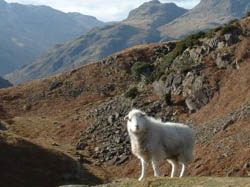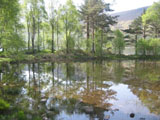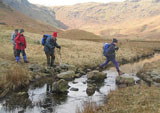|
Your guide to Lake District Food and RecipesThere's a movement back to local food throughout England, partly because many farmers have had to revert to premium food production to turn a profit. The Lake District is no exception to this, and you can find excellent local produce in every corner of the Lakes. We list a variety of the most famous producers below, with recommendations about what to try. We've also published a variety of Cumbrian recipes for your entertainment - ranging from traditional Cumbrian foods such as Mint Cake, Apple Tansy, Gingerbread and so on, which are simple delights that you can find all over the Lakes, to special recipes from some of the Lake District's top chefs. We've also set out some for you to try, lower down this page: so if you want to make the delicious dishes you've sampled in Cumbria when you're back home, you'll have the recipe close at hand.
Local Cumbrian Food ProductsSeveral reasons why you should buy locally
Diversity and local production are also key features in maintaining the landscape.So, to encourage you to buy locally and eat healthy food produced in the Lake District, here is a set of links to local producers, retailers and farmers who we recommend.Suppliers: to be listed here, please contact us on suppliers@lake-district-guides.co.ukCumbrian Meat
Interesting commentary from James Rebanks, on farming, policies, practices and intentions. Cumbrian Dairy ProductsFrom Allerdale goats' cheese through to Lakeland butter, the dairy produce of Cumbria is of special quality, though interestingly enough cow's cheese is not one of the key products of the area. One of the glorious exceptions to this trend is the
range of Kendal cheeses made from milk produced on the Low Sizergh Farm,
near Kendal, where around 120 dairy cows supply milk for cheesemaker Chris
Sandham in Lancashire. He makes Kendal Creamy, Kendal Crumbly and Kendal
Crumbly with Red Onion, all of which are on sale at Low Sizergh Farm Shop. Cumbrian Fruit and VegetablesA local supplier of organic fruit and vegetables in a box delivery scheme is a company called Eva Botanicals, based in Brampton. Lake District RecipesHere we present a series of recipes from Cumbria. You're welcome to submit yours. And for much interesting information on the history of food, particularly with reference to the North of England, see www.historicfood.com Grasmere GingerbreadIngredients
Method 1. Pre-heat oven to 170C / 325F / Gas 3.
Butter a 20 cm (8 inch) sandwich tin. The origin of gingerbread lies in the rich banquets of the 17th and 18th century, where the richly spiced gingerbread was served to help prevent indigestion after the excesses of the fish and meat courses of a meal! Damson Jam Ingredients
Method 1. Put the washed damsons in a pan with the
water and boil for about 20-30 minutes. Pass the jam through a sieve towards the end of the cooking time to
remove the stones. Cumberland Rum NickyIngredients
Method 1. Line a buttered pie plate with half the
pastry and cover with the dates and ginger. Westmorland Mutton and Potato Pie
Method 1. Peel and slice vegetables, trim fat from
meat, slice black pudding. Madeira Braised Shin Of Galloway With Slow Roasted Tomato And Nettle Muffin And Roast AsparagusFrom the chef at the Drunken Duck Inn Madeira Braised Shin 4 x 200g pieces Galloway beef shin, trimmed and tied 250g plain flour 24 thin asparagus Cumbrian Damson CobblerFor the base: For the scone topping: Method 1. Stew damsons, remove stones and put
purée into a greased pie dish. Traditional Cumbrian food was suited to a population who faced a hard life on the hills, eating as economically as possible and using every part of the animal at their disposal.Lake District MeatThe most famous meat products from the Lake District are the Cumbrian sausage and the Herdwick sheep - served as either mutton or lamb. The Cumbrian sausage is traditionally spicy (that's because of the Cumbrian ports' connection with the spice trade again), and made in a long, thick coil of sausage. Good examples are made with lean pork. You can also find Cumberland hams if you look hard enough, sold unsmoked and traditionally dry-cured with salt and brown sugar. There are around a million sheep in Cumbria, and mostly the breeds are the ones noted for their hardiness and resilience. The Herdwick is the traditional upland sheep, with a homing instinct that means it stays on the fells where it was born. Another breed is the Keswick Rough Fell, though in my opinion the Herdwick has a much better flavour. Meat served as lamb will be up to a year old: mutton is older, and rewards slow, careful cooking. Whether served as a roast joint or in shepherds pie, Herdwick mutton is hard to beat for flavour. Lake District Dairy ProduceCumbrian cattle are bred in large numbers, and their milk is used to make delicious butter, yogurt, and cheese. Cumbrian rum butter was a staple of life in days gone by; the remains of the rum butter served at a christening would have coins placed on it to ensure the newborn's prosperity and success in life. Nowadays there's an increasing move towards goats' and sheep's milk cheeses. Lake District FishTrout and salmon were once widespread in the Lakes, though the farming of these fish is increasingly widespread as the natural stocks diminish. Windermere has its own unique species of fish, the char, a relative of the salmon which survived and evolved in isolation in the Lakes. It was originally served potted, or in pies. You can occasionally find them on the menu at local restaurants (try Lucy's of Ambleside) when the stocks are doing well. Lake District FruitWitherslacks (known elsewhere as damsons) and apples grow well in the Lakes. Damsons are rather acidic but cook well: for example, damson and apple tansy (which would originally have included the herb tansy) are rather good puddings (see recipe above). Lake District SweetsKendal Mint Cake has gone across the world on mountaineering expeditions - it's a simple hard paste of sugar and mint, full of energy to sustain you on a trek in the mountains. And Grasmere gingerbread is a famous product - it's been made in Grasmere since 1855. As we've already mentioned, the rum trade was closely connected with the Cumbrian ports, and the legacy lingers on in the form of Cumbrian rum butter and even a modern brand of "Cumbrian rum". The spice trade was big locally, too, and you can find the heritage of this in the cakes which are local specialties, such as Westmorland pepper cake. Lake District foodsMeaty treats Pies, Cumberland sausage, Waberthwaite Bacon, Herdwick Fell bred mutton and lamb Dairy produce Cheeses, butter Something fishy Char, trout Sweet treats Kendal Mint Cake, Cumberland rum butter, Grasmere Gingerbread, Cumberland Rum Nicky, Westmorland Pepper Cake, Damson Jam Pies, puddings and tarts Apple tansy Drinks Lakeland whisky, Damson Wine Organic Food Suppliers - some with mail order service |
|
 The
Herdwick sheep is the archetypal animal of Lakeland, and its natural diet
of fell grass and herbs gives it a superb tasting meat which rewards the
enthusiastic cook and meat eater! It's a healthy animal, too, free of the
diseases which have plagued intensively farmed animals in recent times. To
support all of the farmers who breed Herdwicks, and to maintain the
landscape of the Lakes as it has been for centuries, we urge you to
support the Herdwick Hill Breeders Association's scheme whereby you can
buy a whole or half sheep or lamb ready butchered and delivered to your
door ready for the freezer.
The
Herdwick sheep is the archetypal animal of Lakeland, and its natural diet
of fell grass and herbs gives it a superb tasting meat which rewards the
enthusiastic cook and meat eater! It's a healthy animal, too, free of the
diseases which have plagued intensively farmed animals in recent times. To
support all of the farmers who breed Herdwicks, and to maintain the
landscape of the Lakes as it has been for centuries, we urge you to
support the Herdwick Hill Breeders Association's scheme whereby you can
buy a whole or half sheep or lamb ready butchered and delivered to your
door ready for the freezer.



